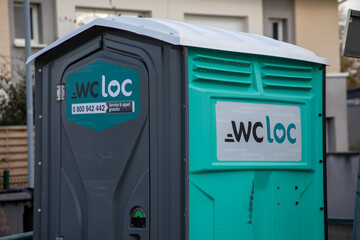 Whether you’re hosting a large outdoor event or preparing for an industrial construction project, there are times when portable toilet rentals come in handy. You’ll want to make sure your guests or employees have a convenient restroom nearby to answer “Mother Nature’s Call.”
Whether you’re hosting a large outdoor event or preparing for an industrial construction project, there are times when portable toilet rentals come in handy. You’ll want to make sure your guests or employees have a convenient restroom nearby to answer “Mother Nature’s Call.”
A good rental company will provide regular servicing, including waste removal and refilling supplies like hand sanitizer. They also have options for deluxe and wheelchair-accessible portable restrooms and luxury trailers. Check out Rent Potty for more details.
Portable Restrooms
One of the most important parts of any event is providing restroom facilities for your guests. People can become irritable, dissatisfied, and even sick without adequate bathroom accommodations. Access to portable toilets can ensure your guests stay happy, comfortable, and safe. Portable toilets are available in many different styles and sizes, so you can find the right one to suit your needs.
Sanitary toilets are a popular choice for outdoor events, since they are affordable and easy to use. They are also easy to clean and can be lined up next to each other in a row to avoid long lines. If you are planning a large event, it’s important to rent enough portable toilets to accommodate all of your guests.
For more upscale events, you may want to consider luxury portable restrooms. These are similar to sanitary toilets, but they have more amenities and are easier to clean. They are a good option for weddings, birthday parties, and other high-end events.
If you are hosting a tailgating party, a portable restroom is a must-have. It will keep your guests happy and healthy, and it will prevent them from using your home bathroom, which is a huge sanitation concern. In addition to having portable toilets, you should also have hand washing stations and food waste receptacles available.
In addition to tailgating, portable restrooms can be a lifesaver at construction sites and other work zones. They can provide a safe and convenient way for employees to dispose of waste, and they can help improve productivity on the job site.
Depending on the type of event you’re planning, you may need to obtain a permit to use portable toilets on public or county property. If you are having a private party at your own home, you may not need a permit for portable toilets. However, if you are planning a large gathering in a public area, then you will likely need to get a permit for the event.
You can find a variety of different portable toilets online that you can rent for your event. The most common types are sanitary and luxury restroom trailers. Each has its own set of benefits and drawbacks, so you’ll need to choose the right one for your event. Sanitary restrooms are generally cheaper than luxury restroom trailers, but they are not suitable for all events. If you’re looking for a luxury portable restroom for an event, then you should contact the company that offers these units and request a quote. You can also ask about any special amenities that they might have. For example, you might be able to find portable bathrooms with a mirror, sinks, and hand washing stations. In addition, you can request a luxury toilet that is climate-controlled, which will make your guests feel more comfortable and luxurious.
Portable Restroom Trailers
If you want a high-end alternative to standard porta potties for your event, consider renting restroom trailers. These larger units are well-lit and offer an experience more like an indoor bathroom than a portable toilet. They also offer amenities that standard portable toilets do not, including sinks, soap and paper towel dispensers, mirrors, and temperature control.
A restroom trailer can be a good choice for an outdoor wedding, sports tournament, concert, weekend-long music festival or other large gathering. It can be positioned near the entrance or exit of your venue to help keep traffic moving and reduce lines for bathroom use. It can also be placed at an offsite location, such as the lakeside or at a camping site.
Portable restroom trailers are usually made of wood or fiberglass, and can be decorated with your company’s logo or design to match your event’s style. Some are designed with classy interiors, which make them a great choice for upscale events. They are also more spacious than their porta potty counterparts, making them a better option for diaper changes and other personal needs. Some are even equipped with showers, which can be a great feature for an outdoor event that will last all day.
You can rent these units on a short- or long-term basis, depending on your needs. Some come with a generator, which is useful if you don’t have access to a power source at your event location. Some portable toilet companies also provide cleaning services, which can save you time and money. They can clean your restrooms on a daily, weekly or monthly basis and can include trash removal as well.
If you decide to go with a portable restroom trailer, you should check with the rental company to see if it requires specific setup requirements. For example, it may need a certain amount of space for installation. You will also need to have a level surface on which to place the trailer. This can be the driveway of your venue or a flat spot at the site where you plan to set up the rental unit.
A restroom trailer can be a great addition to your next outdoor event in Hempstead, New York or any other area on Long Island. To ensure that your guests are comfortable and happy, you should work with a reputable portable restroom rental company to ensure that you have the right options for your needs. Contact CALLAHEAD today to discuss your options for restroom rentals in Brooklyn, Queens, Manhattan, Staten Island and Westchester County as well as Nassau and Suffolk Counties, all the way to Montauk Point. We look forward to helping you impress your guests with our luxurious mobile restrooms. We are the leader in the industry and have been providing mobile toilets since 1976.
Portable Toilets
When it comes to portable toilets, there are a lot of different options available. From a standard porta potty to a bathroom trailer for rent, you can find just about any type of restroom you need for your event. Prices vary, though, and the number of amenities that you add can also affect the cost. It is important to have a clear idea of what you need before you start shopping around for a rental company.
The first step in finding a good rent potty company is to ask for referrals from friends and family members who have had the same need in the past. These people will be able to give you an honest recommendation based on their experience with the company and the quality of the service that they received. They will be able to tell you whether the company is worth hiring for your event or not.
It’s also a good idea to get a quote from several companies before making a decision. This will help you find the best price and make sure that you don’t end up overpaying for your portable restrooms. In addition, it will help you determine how many units to order based on your needs. You should always be prepared for unforeseen circumstances, so it’s a good idea to overestimate how many people you think will attend your event.
Another factor that can influence the price of a portable toilet is its location. Some locations may require additional delivery charges, while others may have special requirements that require more frequent servicing. These requirements can include a higher level of cleaning, restocking, and waste removal. The cost of these services can increase the overall rental price but will offer a better user experience for your guests.
Aside from choosing the right type and number of portable toilets, it’s also important to consider other amenities that will help to make your guests more comfortable. For example, it would be a good idea to provide restroom baskets that contain items like soap, hand sanitizer, a hairdryer, sanitary products, safety pins, and double-sided tape. These items will make your guests feel more welcome and ensure that they have everything that they need to be able to stay clean and comfortable throughout the event.
Having adequate toilets at your event will ensure that the guests are comfortable and will have a great time. This will prevent any embarrassing situations, such as having to stand in line for long periods of time or going without a restroom for too long. Depending on the size of your event, it is recommended that you have at least one portable toilet for every 100 people attending. In fact, it is actually a requirement under OSHA regulations that employers have a portable toilet available to their employees at all times.













